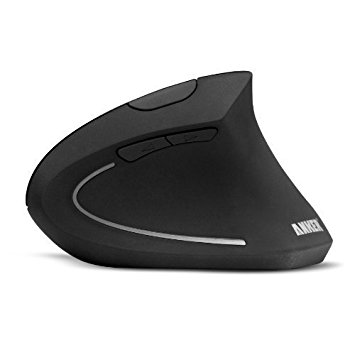If your computer is hurting your shoulders, it’s going to be hard to write.
I’ve written about many computer-related injuries before—including back pain, neck pain, heel pain, eyestrain, and more (you’ll find links to many of these below). A new one that’s been hitting me lately, though, and that has been particularly stubborn, is shoulder pain.
In my search for a solution, I found some very interesting things that I wanted to pass on to you, as I have a feeling that a lot of folks—particularly those who have jumped on the “standing desk” bandwagon—may be suffering from shoulder pain, too.
In fact, I’d go so far as to say that if you have a standing desk right now—even if you stand for only part of the day—you need to make some changes or you’ll soon be suffering from shoulder pain, if you’re not already.
 Computer is Hurting Your Shoulders: Is It Your Mouse?
Computer is Hurting Your Shoulders: Is It Your Mouse?
Computer-related shoulder pain can be caused by a number of things. The first thing one finds when researching the issue is that it can come about from using a computer mouse without the proper arm support.
The Canadian Centre for Occupational and Health Safety says that we use our mice three times as often as we use our keyboards. The more we use them, the more the small muscles in the hand and fingers become strained. Other muscles in the shoulder and shoulder blade tense up, trying to compensate. Over time, this leads to pain—the result of a standard repetitive stress injury.
Common symptoms include pain in the shoulder, pain that radiates down the arms into the hands, tightness and pain in the upper back and shoulder blades, numbness and tingling in the fingers and hands, and pain in the wrist. If you’re feeling pain more on one side than the other, this may be why.
Help Your Shoulders Feel Better
To solve the issue, doctors recommend:
- placing the mouse close by where you don’t have to reach for it—as close to your body as you can,
- adjusting the arm rests on your chair so they support your arm,
- and taking regular breaks, during which you make sure you let your arm and hand hang down.
 During your break, it also helps to get your shoulders moving. Do some shrugs, arm circles, and shoulder circles.
During your break, it also helps to get your shoulders moving. Do some shrugs, arm circles, and shoulder circles.
You may also find some relief using a trackball mouse, since it requires less movement, or a vertical mouse like this one from Anker. If your chair is lacking in arm supports, you can also invest in an armrest, like this one from Ergoguys, or this one from Uarter.
And here’s a good tip to try—switch your mouse hand now and then, and force your opposite hand to take up the job! I’ve been doing this lately and it does help. It takes some time to get used to—and it can be frustrating at first—but usually within a day or two you’ll have it.
 Poor Posture Can Cause Computer-Related Shoulder Pain
Poor Posture Can Cause Computer-Related Shoulder Pain
Simply working at the computer for hours a day, even if you’re doing all the right things with your mouse, can still cause shoulder pain if you’re posture isn’t perfect—and who’s is?
Most of us, when we start to get tired, slouch a little bit. Our shoulders round and the chest caves in. (Read more about avoiding “computer hunchback.”) When we do this every day for years, the muscles in the upper back can become long and weak, while the muscles in the chest become short and tight. The muscles in the chest then pull on those muscles in the shoulders and upper back, causing pain because of a muscle imbalance.
This is so common among those that work long hours on the computer that it’s called “computer shoulders,” and is frequently found in computer programmers. Writers who work many hours at their craft are also likely to suffer from it. If you’re experiencing pain in both shoulders and in your neck, this may be your issue.
How to Help Your Shoulders Feel Better
The solution is two-fold:
- improve your posture,
- and strengthen your core.
We forget to sit (or stand) up straight while working, and we may also be suffering from weak core muscles that fail to support us. Try these solutions:
- Put up a post-it note somewhere at eye level to remind yourself to sit up, pull your shoulders back, and imagine a thread from the top of your head to the ceiling.
- Add some core-strengthening exercises to your weekly routine. Some healthy options less likely to result in back pain include Pilates, push-ups, and the “superman,” in which you lay down face-down on the floor, stretch your arms out in front of you, then lift one arm, along with your head and opposite leg, about two inches off the floor. Hold for 10-20 seconds and repeat on the other side. Perform 5-10 reps.
 Standing Desks Can Cause Shoulder Pain!
Standing Desks Can Cause Shoulder Pain!
The previous two things—posture and the positioning of your mouse—can cause shoulder pain, and have caused pain in computer users for years. But today, we have a new source of shoulder pain—standing desks.
Many writers and other professionals are using standing desks now, and that’s a good thing, as long as you don’t stand at them all day long. Standing for a while and then sitting for a while can be much better for your lower back, hips, and overall fitness than sitting all day long.
Unfortunately, after using these things for a few years, we now know that they aren’t perfect and that standing desks can cause pain, too. I talked about how they can cause you to develop heel pain in a previous post.
Well, guess what? Standing desks can cause shoulder pain, too. One of these days, someone’s going to invent the perfect writing position and supportive furniture, but I’m afraid that’s going to take awhile. (sad face)
What Causes This?
Part of the problem with standing is posture. (Here we go again, right?) Most of us aren’t used to standing up straight, particularly since we’re using gadgets like smartphones and tablets all the time that bring our heads forward and down, and our shoulders around.
Even if you start out with good posture, as you get tired later in the day, that posture is likely to deteriorate. Particularly if you’ve spent years writing while sitting and then you switch to standing, your core and glute muscles are likely to be weak, and they won’t support you in this new position like they should. (Read more about how weak glutes can create back pain.)
On top of that, guess what? Most of the time, when using a standing desk, you have no arm support. Zippo.
So you’re actually creating more strain on your neck and shoulders when standing than when you’re sitting down, because gravity is working harder on your arms, and requiring your other muscles to work harder to compensate.
That can cause shoulder and back pain in a hurry.
 Computer Hurting Your Shoulders: Is It Your Keyboard?
Computer Hurting Your Shoulders: Is It Your Keyboard?
The other problem for most people at a standing desk is the position of their keyboards.
Most put them at a 90-degree angle—like they’re told to do when sitting—but for standing, that spells disaster. Your back and shoulder muscles have to work extra hard to keep your arms in this position—harder than they do when you’re sitting.
There’s a great article over at “QuittingSitting.com” that explains why this is, and has some good diagrams showing that a better position when you’re standing is to angle the arms down quite a bit more, and work with the elbows more open. I tried this, and it helped a lot.
They also recommend a negative-tilt keyboard—tilting the keyboard away from you—which again, helps relieve the angle in your arms.
So when you’re standing, remember to stand up straight, take frequent breaks during which you move and stretch your shoulders, position your keyboard down and forward, and if you can, get some arm support. With standing desks, though, this last tip can be difficult.
In fact, I was unable to find any standing-desk arm supports in my research. If you know of some, please include them in the comments below!
 7 Exercises to Help When Your Computer is Hurting Your Shoulders
7 Exercises to Help When Your Computer is Hurting Your Shoulders
Fortunately, there are a number of stretches you can do to help relieve computer-related shoulder pain. I’ve got a few listed here.
Sit against the wall
For this exercise, sit down up against a wall, scooting your backside up against it as close as you can. Press the back of your head up against the wall as well, and pull your shoulder blades back so they’re pressed against the wall, too. Put your hands in your lap, and stretch your legs straight out in front of you, toes flexed toward you. Hold for five minutes.
One-arm doorway stretch
Stand in a doorway, and place one forearm against the frame with your elbow at a 90-degree angle. Keeping your arm pressed against the frame, slowly lean your body forward until you feel the stretch. To deepen the stretch, turn your head the opposite way. Hold for 15 seconds and repeat on the other side, at least 3 repetitions for each side.
In-chair shoulder stretch
While seated, position your hands behind your head, fingers laced. Slowly lean your upper back over the back of the chair until you felt the stretch in your upper back. Hold for 15 seconds, and repeat 5 times.
Flying stretch
Hold both arms out at your sides, at right angles to your body. Place your hands palms out, fingers pointed toward the ceiling as if you were bracing yourself against a wall on either side of you. You’ll feel a stretch in your arms and shoulders. Hold for 20 seconds and repeat.
Clock stretch
Lie on your side with knees bent and together and your arms straight and stacked in front of you, palms together like you’re holding an imaginary pistol. Keeping your knees together and your legs still, imagine your top arm as the hand of a clock, and trace a big circle around you, keeping your hand touching the floor all the way around if you can. As you come to the middle of the circle, you can open up your chest and head toward the ceiling, but keep your hips and legs still. Draw five circles and repeat on the other side.
Child pose
This is a common pose in yoga, but if you don’t do yoga, don’t worry, it’s easy. Start on your hands and knees, then lean back and rest your backside on your heels. Sit up straight, separate your knees a bit, then fold forward and let your forehead rest on the floor, your chest on or between your knees. Keep your arms extended in front of you, palms down. Rest for a minute or longer.
Anterior shoulder stretch
Place one arm across the front of your body, and use the other hand to grasp the elbow. While holding our arm straight, pull your arm across and closer to your body without twisting. Hold for 20 seconds, and repeat on the other side.
To find out if your posture may be causing your problems (while either sitting or standing), check out this great video from ModernHealthMonk, which has a way to test your posture. I definitely came up short!
Here’s another good video from Upright Health on easing shoulder pain from computer strain—the tennis ball trick at the end really helps work out those knots:
One more suggestion—thriller writer Chuck Barrett mentioned in his Writing and Wellness feature a posture shirt that helps encourage good posture. Check it out here.
How do you deal with computer-related shoulder strain?
Sources
“10 Ways to Fix Your Mouse Shoulder Pain, Now,” Pain Doctor, https://paindoctor.com/mouse-shoulder/.
“Computer Mouse—Common Problems from Use,” Canadian Centre for Occupational and Health Safety, https://www.ccohs.ca/oshanswers/ergonomics/office/mouse/mouse_problems.html.


I’ve used an armless task chair for years because the arms on desk chairs are usually too high for me. The arm rest extension looks like a great idea to try.
One of the things I’m doing to help relieve shoulder and wrist pain is to use my mouse less when reading articles and blog posts. My old habit was to keep my hand on the mouse all the time. Now I dangle my arms to my sides and reach for the PgUp or PgDn keys when I need to move the page.
Yes they look like they have more options now—at least for when you’re sitting. Good tip on the scrolling—thanks! :O)